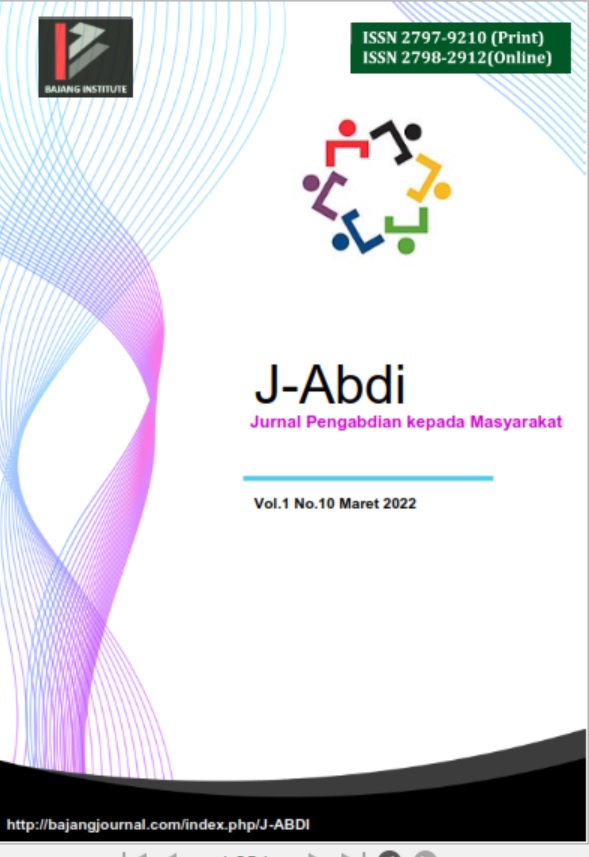PEMBERDAYAAN KEWIRAUSAHAAN UNTUK ANAK TUNARUNGU DENGAN PEMBUATAN SELAI NANAS
DOI:
https://doi.org/10.53625/jabdi.v1i10.1634Keywords:
Entrepreneurship, Deaf Children, And Pineapple JamAbstract
One of the aspirations that partners want is for deaf children to have an entrepreneurial spirit. Entrepreneurs have an important role in permeating business activities with an entrepreneurial spirit and turning that spirit into energy to engage in reforms, especially in the manufacture of pineapple jam. Deaf children are taught how to process, distribute, and market products. For this reason, through the Intellectual Product Business Development Program the "Educational" Campus will be given Entrepreneurship Empowerment Training for Deaf Children Through Making Pineapple Jam, in order to prepare deaf children in Palangka Raya to become independent individuals and able to do entrepreneurship through making pineapple jam. The targets achieved are (1) Enhancing Entrepreneurial Capability for Deaf Children Through Making Pineapple Jam; and (2) the production of a guide module for making pineapple jam for deaf children with a unique taste. The implementation of community service "Entrepreneurship Empowerment for Deaf Children Through Making Pineapple Jam," begins with an approach, then implementation in the field. After the implementation in the field, an evaluation is carried out, what are the obstacles faced in the training. Through these processes, it is hoped that the training can achieve the targets desired by partner one and partner two. Lastly, assistance was provided.
References
Astono, Rianto. 2016. Facebook Marketing. Palembang: Gaptex Indo Media.
Christine, J. (2016). Pemerolehan Bahasa Anak Tunarungu. Jurnal Penelitian dan Pengembangan Pendidikan Anak Usia Dini, 3(2), 95-104.
Christy, N. A. (2020). Revitalisasi Pembelajaran Bahasa dan Sastra Indonesia Selama Masa Pandemi Covid-19. Enggang: Jurnal Pendidikan, Bahasa, Sastra, Seni, dan Budaya, 1(1), 1-15.
Djamarah, Syaiful Bahri. 2000. Stategi Belajar Mengajar. Jakarta: PT Rineka Cipta.
Khair, U., & Misnawati, M. (2022). Indonesian language teaching in elementary school: Cooperative learning model explicit type instructions chronological technique of events on narrative writing skills from interview texts. Linguistics and Culture Review, 6, 172-184.
Misnawati, M., & Rahmawati, E. (2021). Emosi dalam Naskah Drama Sampek dan Engtay Karya Norbertus Riantiarno. Syntax Literate; Jurnal Ilmiah Indonesia, 6(7), 3360-3379.
Nurachmana, A., Purwaka, A., Supardi, S., & Yuliani, Y. (2020). Analisis Nilai Edukatif dalam Novel Orang-orang Biasa Karya Andrea Hirata: Tinjauan Sosiologi Sastra. ENGGANG: Jurnal Pendidikan, Bahasa, Sastra, Seni, dan Budaya, 1(1), 57-66.
Perdana, I., & Misnawati, M. P. (2019). Cinta dan Bangga Berbahasa Indonesia Di Perguruan Tinggi. SPASI MEDIA.
Pratiwi, Ratih Putri dan Afin Murtiningsih. 2013. Kiat Sukses Mengasuh Anak Berkebutuhan Khusus. Yogyakarta: Ar-Ruzz Media.
Rahmah, F. N. (2018). Problematika anak tunarungu dan cara mengatasinya. Quality, 6(1), 1-15.
Rinto Alexandro, M. M., Misnawati, M. P., & Wahidin, M. P. 2021. Profesi Keguruan (Menjadi Guru Profesional). Gue.
Rusdiana, A. (2018). Kewirausahaan: Teori dan Praktek.
Sitepu, K. H. B., Poerwadi, P., & Linarto, L. (2021). Realisasi Ilokusi Tindak Tutur Direktif Dalam Dialog Proses Belajar Mengajar Mata Pelajaran Biologi di SMAK Santo Aloysius Palangka Raya. ENGGANG: Jurnal Pendidikan, Bahasa, Sastra, Seni, dan Budaya, 2(1), 79-90.
Somantri, T. Sutjihati. 2006. Psikologi Anak Luar Biasa. Bandung: PT. Refika Aditama.
Sukmadinata, Nana Syaodih. 2009. Landasan Psikologi Proses Pendidikan. Bandung: PT Remaja Rosdakarya.
Supiani, S., Muryati, D., & Saefulloh, A. (2020). Pelaksanaan Kegiatan Ekstrakurikuler Keagamaan Di Man Kota Palangkaraya Secara Daring. ENGGANG: Jurnal Pendidikan, Bahasa, Sastra, Seni, dan Budaya, 1(1), 30-39.
Warianie, L. (2020). Peranan Penting Guru, Orang Tua dan Siswa Dalam Menghadapi Pembelajaran Jarak Jauh di Masa Pandemi Covid 19. ENGGANG: Jurnal Pendidikan, Bahasa, Sastra, Seni, dan Budaya, 1(1), 16-29.















